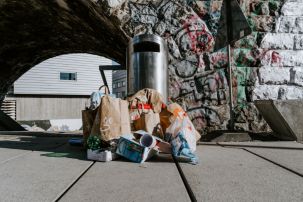Lesson summary
In this activity students map the distribution and composition of litter in the school courtyards and grounds. Students work in groups to count the number of litter items across the school. Groups then come together to compile their information to create a complete picture of litter at your school.
Learning intentions:
Students will...
- understand that litter can be found to varying degrees in every school.
- recognise that litter has many negative impacts for people and animals in the environment, and can have impacts far away from the school site.
- recognise that reducing litter can have many benefits for the school community and the environment in general.
Lesson guides and printables
Lesson details
Curriculum mapping
Australian curriculum content descriptions:
Geography Year 5:
- Locate and collect relevant information and data from primary and secondary sources (ACHASSI123)
- Present ideas, findings, viewpoints and conclusions in a range of texts and modes that incorporate source materials, digital and non-digital representations and discipline-specific terms and conventions (ACHASSI105)
- Reflect on learning to propose personal and/or collective action in response to an issue or challenge, and predict the probable effects (ACHASSI104)
Mathematics Year 5:
- Pose questions and collect categorical or numerical data by observation or survey (ACMSP118)
- Construct displays, including column graphs, dot plots and tables, appropriate for data type, with and without the use of digital technologies (ACMSP119)
Science Year 5:
- Scientific knowledge is used to inform personal and community decisions (ACSHE217)
- Construct and use a range of representations, including tables and graphs, to represent and describe observations, patterns or relationships in data using digital technologies as appropriate (ACSIS090)
- Communicate ideas, explanations and processes in a variety of ways, including multi-modal texts (ACSIS093)
Geography Year 6:
- Locate and collect relevant information and data from primary and secondary sources (ACHASSI123)
- Present ideas, findings, viewpoints and conclusions in a range of texts and modes that incorporate source materials, digital and non-digital representations and discipline-specific terms and conventions (ACHASSI133)
- Reflect on learning to propose personal and/or collective action in response to an issue or challenge, and predict the probable effects (ACHASSI132)
Mathematics Year 6:
- Solve problems involving the comparison of lengths and areas using appropriate units(ACMMG137)
- Interpret and compare a range of data displays, including side-by-side column graphs for two categorical variables (ACMSP147)
Science Year 6:
- With guidance, plan appropriate investigation methods to answer questions or solve problems (ACSIS103)
- Compare data with predictions and use as evidence in developing explanations (ACSIS221)
- Communicate ideas, explanations and processes in a variety of ways, including multi-modal texts (ACSIS110)
Cross curriculum priorities:
Sustainability – OI.3 – Sustainable patterns of living rely on the interdependence of healthy social, economic and ecological systems. OI.5 – World views are formed by experiences at personal, local, national and global levels, and are linked to individual and community actions for sustainability. O1.7 Actions for a more sustainable future reflect values of care, respect and responsibility, and require us to explore and understand environments. O1.9 Sustainable futures result from actions designed to preserve and/or restore the quality and uniqueness of environments.
General capabilities: Numeracy, Critical and creative thinking
Syllabus Outcomes: GE3-4, ST3-6PW, ST3-4WS, MA3-10MG, MA3-18SP, MA3-9MG, MA3‑1WM, MA3‑2WM, MA3‑3WM.
Connecting lessons: Waste audit – must be completed as a compulsory action.
Resources required
- Map or plan of the school grounds
- Student worksheet
- Clip board (if using printed copies of worksheet)
- Map or plan of the school grounds
- Student worksheet
- Clip board (if using printed copies of worksheet)
Additional Info
NOTE: Although this activity has been created in support of the ResourceSmart AuSSI Vic program you will not meet the data goals of the program through this activity.
This activity has been created to give younger students – for whom the official water audit would be too complex – an opportunity to participate in the water component of the ResourceSmart AuSSI Vic program. To gain accreditation your school will still need to complete the more complex water audit.


Welcome back!
Don't have an account yet?
Log in with:
By signing up to Cool.org you consent and agree to Cool's privacy policy to
store, manage and process your personal information. To read more, please see
our privacy policy here(Opens in new tab).
Create your free Cool.org account.
Many of our resources are free, with an option to upgrade to Cool+ for premium content.
Already have an account?
Sign up with:
By signing up to Cool.org you consent and agree to Cool's privacy policy to
store, manage and process your personal information. To read more, please see
our privacy policy here(Opens in new tab).